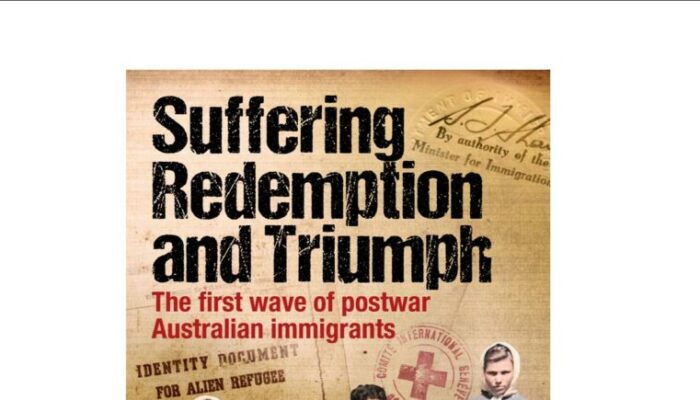Book Review – Suffering, Redemption and Triumph: The First Wave of Post-war Australian Immigrants
“Suffering Redemption and Triumph: The first wave of postwar Australian immigrants”, Peter Brune, Big Sky Publishing, 2023, 436 pages
After discovering a box of his interview tapes from 25 years ago, the military historian Peter Brune was inspired to resume his project to publish the oral histories of about 40 immigrants, who came to Australia from the Baltic states of Latvia, Lithuania and Estonia, Ukraine, Czechoslovakia, Slovenia, Poland, Hungary, Serbia, Greece, Italy, and Croatia. They came in the immediate post-World War 2 period and, since he conducted the original interviews, most of them have passed, so these accounts are irreplaceable. He includes maps of individual journeys, their war histories and how it changed them, their quest for suitable “documents” and identities, and the complicated politics, ideologies and events which buffeted them, including the looming confrontation between “The Iron Curtain” and the West. Brune’s book also reports their post-arrival experiences of Australian policies, such as the separation in job locations of married couples, their quest for improvement, and where all this took them (up to 2001). Sometimes adult children are included in the conversations. Important points are made by Brune in his evaluation of Australia’s “nation-building” objectives, such as the wastage of skilled and professional workers due to credentialling barriers, still claimed to operate against new migrants and refugees in the dental industry today.
The government’s population growth objective, decided in 1942, was for a 2% annual increase, 1% from births, and 1% from immigration, and it was known that the numbers of (preferred) UK migrants were always going to be inadequate. The program started with the “Beautiful Balts”, white-skinned from Northern Europe, in the Mass Resettlement Scheme of 1947-53, and the larger Special Projects Scheme 1951-53, focused on tradesmen from Germany, Holland, France, Austria and Italy. Due to European reconstruction and competition from Canada and others, the migrant shortages continued, so recruitment of former “enemy aliens” from Germany began, with 100,000 Germans coming to Australia from 1954 to 1961. The International Refugee Organisation (IRO) stipulated that likely Nazi collaborators – those involved in the eradication of ‘undesirable’ communists, Jews, Gypsies and mentally handicapped people – were meant to be immediately arrested yet their official, yet illegal, selection to serve the Australian state happened during the first program. In Canberra, war criminals, quislings and traitors were, in many cases, considered to be of great benefit in the coming Cold War, and the competition to recruit “talent” took precedence, with short cuts to bypass the process making Australia a more attractive destination as well. Brune celebrates the investigations of Mark Aarons in exposing this in Sanctuary (1990) and War Criminals Welcome (2001), and gives the issues specific and detailed consideration in Chapter 6 (‘An Immoral Episode’).
Seeing Australia as a British outpost, an aversion to different ethnicities, such as Jewish migrants, was common at the official level as well as pervasive in society. Brune’s account of how political leaders like Calwell and Holt defused this by the political arts of deception, blackmail, compromise and maneuvering is interesting. The racist influence of senior officials, the RSL national secretary, ACTU Secretary Albert Monk (Bob Hawke’s immediate predecessor) and even northern Italians already in Australia towards southern Italians, meant restrictions on Italian immigration. This is despite one report which said that “so far as personal cleanliness is concerned, the Italian does not suffer by comparison with the lower class Australian.” Financially assisted passages from the Australian government were significantly less for Italians, Cypriots and Greeks compared to British and German migrants, undermining the “assimilation” which the government thought desirable. We should note that the end of the White Australia Policy was still almost two decades away, with an Asian paranoia feeding enthusiasm for war in Indochina in the interim period. Although Dutch immigrants were highly favoured, if the wife or husband was of Indonesian or not “pure European” descent, a financially-assisted passage under the 1951 Netherlands-Australian Migration Agreement (NAMA) was not provided by Australia. Brune hopes, in documenting these individual and trans-societal encounters, that we, as well as celebrate the social and economic benefits, reflect on what can be learnt about ourselves and Australian society, as it irrevocably moved in a new and different direction.
Peter Brune is clearly not a passive observer recording history far from the front line, and raises one of the big human dilemmas: “perhaps the most critical, ethical conundrum of the Holocaust: how can one be moral or virtuous when one is under duress?” He quotes Kitia Altman, a Polish Jew: All extreme and critical situations, you never knew how you would behave. It doesn’t matter what you think, you would say, ‘I would never do that!’ You never knew until you are in that situation. And no intellectual or moral preparation prepares you for the actual response.” (p 88) But resistance can be more than a personal act or a violent response: he highlights the nation-wide strike by the Netherlands civilian population against the transportation of Jews to a concentration camp in February 1941. The leaders were executed, but this was a brave collective stand against the Holocaust, unique in the whole period of Nazi-occupied Europe.
The book is fair-minded and empathetic towards its subjects, whose lives it has reported over different phases, going far beyond a case study approach. It displays deep knowledge of the period, is elegantly written and edited, and a delight to read.
Kevin Bain is a retired economic analyst and university teacher. His Refugee Reading Guide is at Bayside Refugee Support. It has short summaries of about 100 books published over the last 20 years.
